
7
able to rotate freely about the R.A. axis. Rotate it until
the counterweight shaft is parallel to the ground (i.e.,
horizontal).
2. Now loosen the counterweight lock knob and slide the
weight(s) along the shaft until it exactly counterbalances
the telescope. That’s the point at which the shaft remains
horizontal even when you let go with both hands. Once
balance is achieved, retighten the counterweight lock
knobs.
3. To balance the telescope on the Dec. axis, first tighten
the R.A. clutch, with the counterweight shaft still in the
horizontal position. Then with one hand on the telescope
optical tube, loosen the Dec. clutch and check for
any spontaneous rotation. If there is some, adjust the
telescope forward or back in the saddle or in its tube
rings until it remains horizontal when you carefully let
go of it. (It’s best to return the telescope to an upright
position before adjusting it forward to back in the saddle!)
The telescope is now balanced on both axes. When you loos-
en the clutch on one or both axes and manually point the tele-
scope, it should move without resistance and should not drift
from where you point it.
Part 3: usinG tHE sirius
Pro aZ/EQ-G Mount
3.1 Manually rotating the Mount
The mount can be moved manually by simply loosening the
R.A. and Dec clutches and pointing the telescope to the
Figure 13.
R.A. and Dec setting circles can be used to
locate objects “the old fashioned way.”
Figure 12. a)
Loosening the Dec. clutch wheel lets you
rotate the dovetail saddle to a horizontal position. Be sure to
tighten the clutch before installing your telescope!
B)
Tighten
the two rosette knobs to secure your telescope in place.
Saddle
Locking
thumbscrew Arrow (pointer)
R.A. Setting circle
Dec clutch
wheel
a
B
Knobs
Saddle oriented
horizontally
Arrow (pointer)
Dec. Setting circle
Locking
thumbscrew
Содержание Sirius Pro AZ/EQ-G
Страница 15: ...15 ...

































